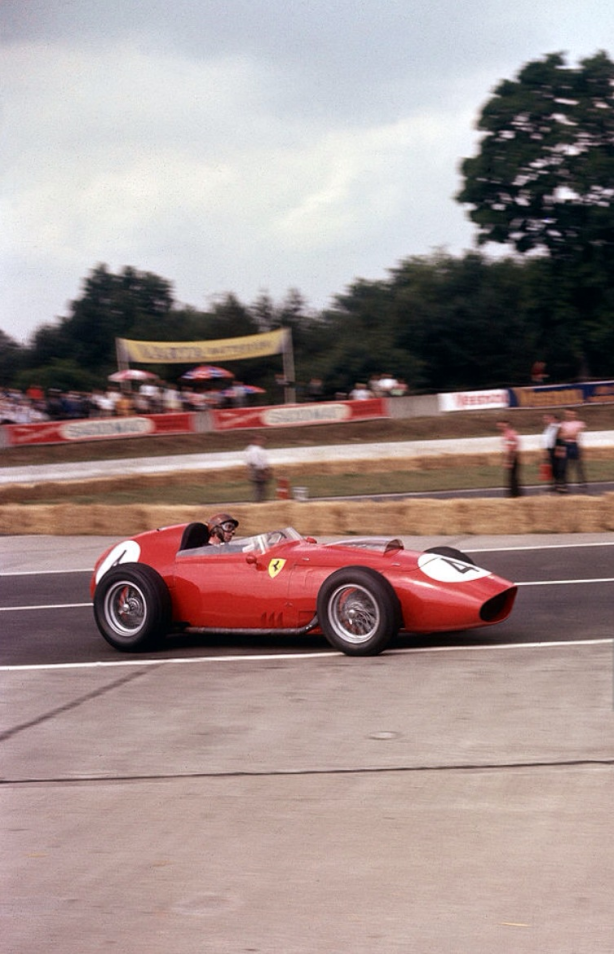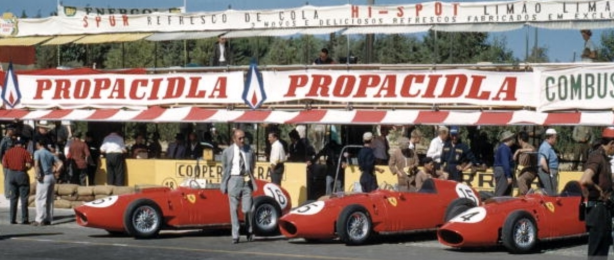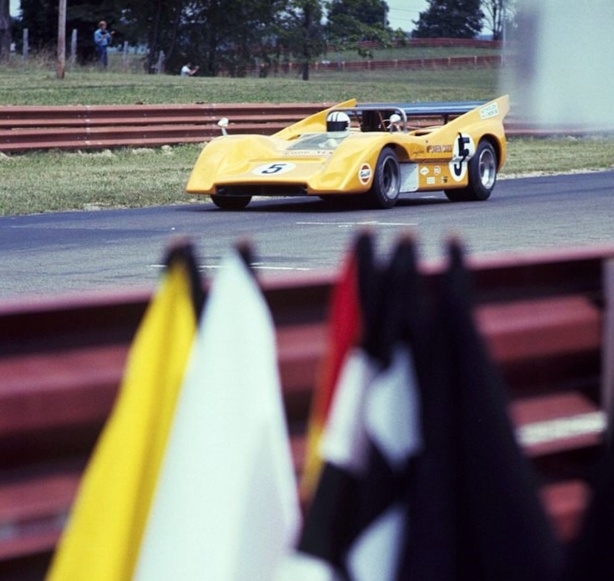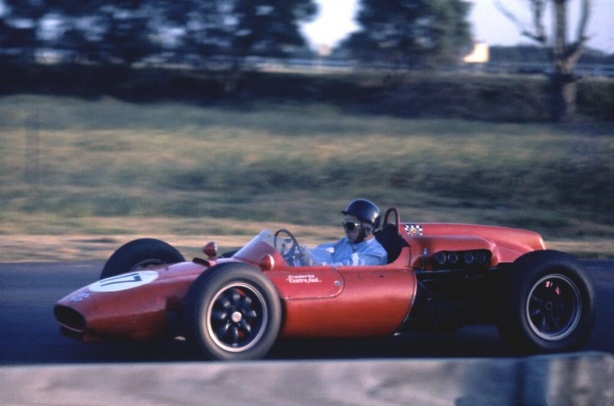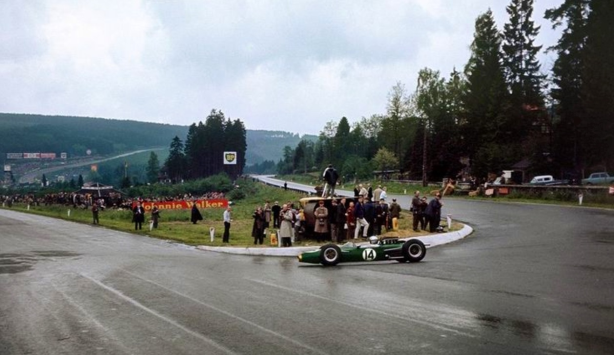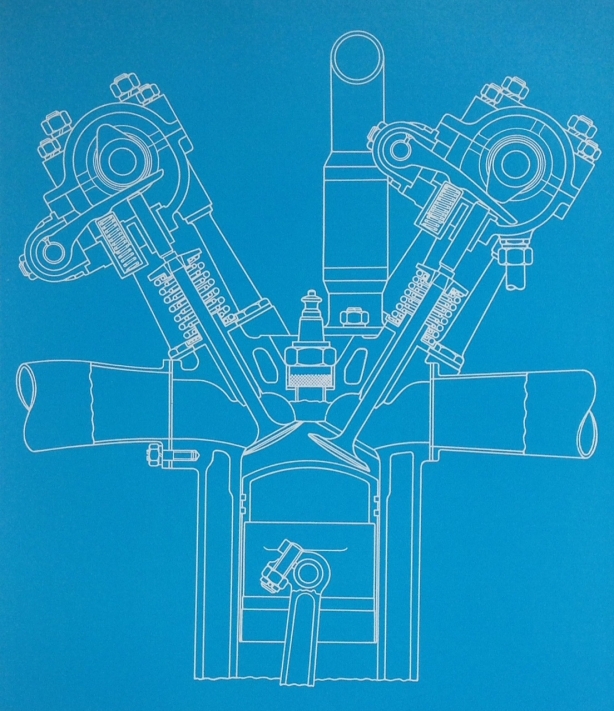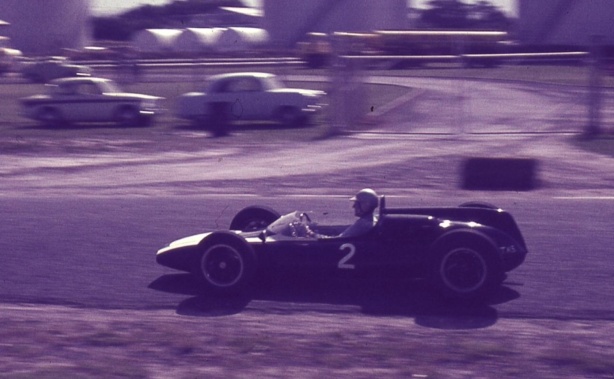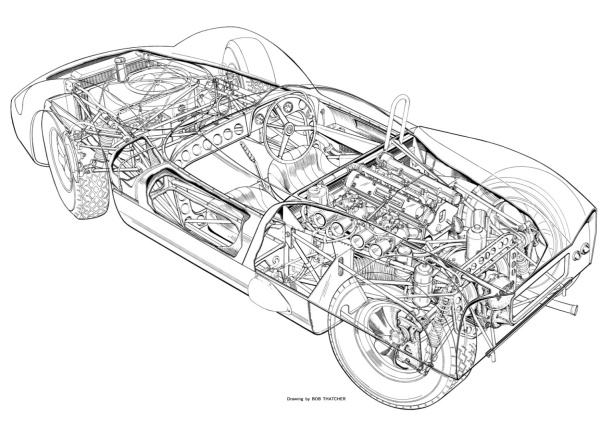Looks of wonderment and amazement at the voluptuous lines of the Aston’s Frank Feeley penned body. The ‘Wow Factor’ of contemporary racing cars never changes whatever the era does it?!…
Here it’s a Melbourne crowd on February 28 1958. Its the end of the long hot Australian summer but the crowd are well rugged up, Melbourne is notoriously ‘four seasons in one day’ sometimes and Fishermans Bend is an exposed windswept place at the best of times. At the wheel of the road-registered, ex-works Aston Martin DB3S chassis DB3S/9 is a youthful David McKay.

McKay aboard DB3S/9 at Fishermans Bend in February 1958. Nose of the car showing minor scars of battle, perspex headlight covers fitted to this car from its birth. First race the ’56 Rouen GP in May, then 2nd @ Le Mans ’56 driven by Moss/Collins, Salvadori was 2nd at Goodwood in September- car retained by Astons into 1957, the DBR1 the front line weapon that year with Brooks racing DBS3/9 at Easter Goodwood for 3rd. It was then used by the works for the last occasions as a practice car at Silverstone for the British Empire Trophy and for the Nurburgring 1000Km before sold by John Wyer to McKay with funds provided by Ampol (Westaway)
At the time he was ascending the driving ranks having cut his racing teeth in MG’s. He made it into the elite group too- let’s not forget were it not for a ropey jumped start call he would have won the 1961 Australian Grand Prix at Mallala aboard a Cooper T51 Climax. David would soon be known as much as a journalist, successful businessman and entrant-entrepreneur via his business ‘Scuderia Veloce’ as a driver though.
McKay raced this car to wins in the sportscar races that Fishermans Bend weekend, and was very successful in it throughout the country, taking 8 wins from 9 starts.
His only defeat, 2nd place was at the hands of Doug Whiteford’s ex-works Maser 300S in the Tasmanian Tourist Trophy at Longford in early 1958 during the Gold Star meeting.
After Longford McKay and his crew took the car south to Hobart racing it at the new Baskerville circuit (above) in April and taking a comfortable win, and setting a new outright circuit record from Lyn Archer’s Cooper 1100 but churning through more of his diminishing stock of racing Avons due to the abrasive nature of the surface.
An amusing side-story is that the officer in charge of the old SS Taroona ship between Devonport and Port Melbourne took exception to the oversized trailer and refused to load it until David made representations to the Captain who graciously allowed the equipe aboard ensuring that important commitments to sponsors could be met.

Engine of the ex-works/McKay DB3S/9, raced at Albert Park, November 1958 by Stan Jones. 6 cylinder 2922cc DOHC 2 valve, twin plug all alloy engine fed by 45DCO Weber carburettors. Circa 225bhp @ 6000 rpm (Kevin Drage)
His last race in the car was successful, he took an Australian Tourist Trophy victory at Mount Panorama, Bathurst in October 1958 in what McKay described as ‘the faithful old ex-works Aston’s…greatest Antipodean win’.
The race was not an easy one. Initially Bill Pitt’s Jaguar XKD led and then Doug Whiteford, the formidable, forceful three-time AGP winner took the lead from McKay with Pitt 3rd. On lap 10 Doug had an enormous accident when the Maser was caught by a sudden gust of wind after coming over the second Conrod Straight hump threw the car out of control with the Maser spinning and hitting the right hand fence three times. Whiteford was almost flung from the car as it skidded backwards down the escape road and into another fence. Fortunately the St Kilda racer was only bruised by the wild ride.
McKay then led with an intermittent engine miss from Derek Jolly’s Lotus 15 Climax, a light rain shower adding to the degree of difficulty towards the end of the race. McKay won from Jolly, Ron Phillips and Frank Matich- Aston DB3S, Lotus 15 Climax, Cooper Jaguar and Jaguar XKC.
The weekend was a brilliant one for the Sydneysider as his new Jaguar Mk1 3.4, just imported for him by Ampol trounced the hitherto dominant Repco headed Holden sedans of John French and Leo Geoghegan in the sedan car handicap, to start the ‘Jaguar Era’ of Australian Touring Car racing.
After the Tourist Trophy win Stan Jones bought the racer but wasn’t really happy with it. The wonderful Le Mans second placed 1956 car then passed into Ray Barfield’s hands in Western Australia where its contemporary racing history ended in the early sixties. A summary of the cars history is in this article, rather than repeat myself;
‘Bunbury Flying 50’, Allan Tomlinson, Ferrari Tipo 500 et al…

McKay’s first Aston, a production DB3S chassis #102 in the Carrathool paddock during its Australian LSR record breaking weekend in February 1957. Interesting to know who crafted the aero pod beneath which McKay sat and cooked! (Jek)
McKay was a very dab hand at the wheel of Aston’s by the time he bought his ex-Moss car…
He was part of the trio of privately run DB3S, ‘Kangaroo Stable’ of cars raced by Australians Tony Gaze, Jack Brabham, Les Cosh, Dick Cobden, Tom Sulman and McKay in Europe in 1955.
McKays car, initially delivered to Tony Gaze, chassis DB3S/102 took the best result of the tour cut short by the cancellation of many sportscar races in Europe after the Le Mans disaster- McKay and Gaze were second in the 29 May Hyeres 12 Hour behind the winning Ferrari 750 Monza driven by Canonica/Munaron
At the end of the European Safari which included Oporto (Gaze 8th) and Goodwood (McKay/Gaze DNF distributor drive) David shipped the car straight to New Zealand for a number of races there including the Formula Libre NZ GP in January 1956,he retired from the Ardmore event won convincingly by Stirling Moss in a Maserati 250F.
The engine of the car was shipped back to the UK for a rebuild after a major failure during a race at Invercargill. From May 1956 production DB3S’ were fitted with twin-plug 210 bhp engines, it was in this form the engine was rebuilt and delivered from Feltham back to Sydney. The beautiful car was again race ready by early 1957.

Tony Gaze about to rejoin the May 1955 Hyeres 12 Hour, he shared the car with David McKay- car #20 behind is the Graham and Peter Whitehead DB3S DNF (CAMS)
The stunning colour photographs were taken of ‘102’ in February 1957 at Carrathool a tiny village 680 Km west of Sydney between Narrandera and Hay in New South Wale western Riverina.
The main automotive attribute of the town was a long, straight stretch of road between Carrathool and Gunbar which was ideal for record setting, and so it was that various Ampol sponsored cars sought to break some Australian speed records. The then current Australian LSR was the 136.4 mph set by Jack Saywell’s 2.9 litre Alfa Romeo Tipo B/P3 at South Australia’s Coorong in 1939.
After plenty of careful preparation inclusive of incorporating the beautifully made perspex fairing onto his Aston, McKay broke the record setting a time over the Flying Kilometre of 143.19 mph on the morning of 19 February 1957. The ‘Canberra Times’ reported that McKay made two full speed runs on the course, ‘during one run he skidded on a patch of loose dirt at 140 mph’.
This speed was soon eclipsed by other cars but the DB3S held the class record for some years.

David McKay at speed during the Ampol sponsored record-breaking weekend in early 1957. Carrathool a tiny hamlet with now around 300 inhabitants. A straight, flat road with a decent surface a long way from major population centres was ideal record breaking territory! (Jek)
The car was first raced in Australia at Easter Bathurst in April 1957, he was 2nd in the sportscar handicap and won the sedan and sportcar handicap from Paul England’s Repco headed Ausca, passing the very fast special built at Repco Research by England ‘running up to 139.3 mph to do so and clocking fastest quater mile time for the day’.
But the car saw little further use as the quicker ex-works machine arrived in Sydney in September 1957. DBS/9’s first race was the October 1957 13 lap NSW Sportscar Championship at Bathurst, an event the combination won comfortably with McKay taking the lap record despite using only 5200 of the Aston’s available 6000 rpm. Bill Pitt’s Jaguar D Type was timed at 144 mph on Conrod Straight with McKay at 136 mph using his self imposed rev limit.
Both of these extremely valuable cars still exist but sadly left Australia many years ago. Those of you with collections of Australian ‘Sports Car World’ magazine should have a fossick through them as McKay wrote two sensational articles about the ownership of his two Aston’s in the seventies, or maybe the eighties!..
Aston DB3S Technical Specifications…
The Aston Martin DB3S was built from 1953 to 1957, 32 were constructed excluding the single-seater variant ‘DP155/1′ raced by Reg Parnell in New Zealand in 1956.
Fundamentally Willie Watson’s design was a shorter, lighter and stiffer car than Eberan Eborhorst’s Aston DB3. The car evolved over just four months making its debut in Reg Parnell’s hands at Charterhall on 23 May 1953.
The cars were designed around a period typical ladder frame chassis which was 7 feet 3 inches long- 6 inches shorter than DB3. The frame comprised twin tubular members of 4 inch 16 gauge chrome molybdenum steel and three 14 gauge four, and five inch cross-members. The shorter chassis made the car nimbler than its predecessor if somewhat skittish on bumpy surfaces. The track was reduced from 4′ 3″ to 4’ 1″.
Frank Feeley designed the very stylish body, as sexy as the DB3 was dowdy. More than a nod had been given in the direction of the contemporary Maserati A6GCS it seemed. Overall the car was shorter, narrower and lighter than the DB3 and importantly it ‘looked right’ straight out of the box.
Front suspension was independent by trailing links, torsion bars, piston type dampers and a roll bar. A De-Dion rear axle was used sprung by a torsion bar and located by trailing links and a Panhard rod, again with piston type shocks.
Naturally a David Brown gearbox was fitted, the S430 ‘box a 4 speeder with reverse, final drive was by spiral bevel in a light alloy casing with a ZF slippery diff usually fitted. Brakes initially were two-leading shoe Alfin drums- 13 inches in diameter at the front and 12 inches at the rear. From 1955 Girling disc bakes were specified, the rotors were 11.5 inches in diameter front and rear. Precise rack and pinion steering was fitted, two turns were required lock to lock.
A 2922cc all alloy DOHC, 2 valve, 6 cylinder engine provided the cars heart. It had 4 main bearings and wet cylinder liners with the valves disposed at an included angle of 60 degrees. Initially fitted with 35DCO Weber carburettors the engine gave 182 bhp @ 5500 rpm and 182 lb/ft of torque at 3800 rpm on a compression ration of 8.5:1.
The cars were of course developed extensively throughout their racing life with the works cars fitted with twin-plug heads and 45DCO Webers from May 1954 giving 225bhp @ 6000 rpm.
The ‘Kangaroo Stable Cars’ (DB3S/102 Gaze-McKay, DB3S/103 Sulman, DB3S/104 Cosh) delivered in early 1955 all had the 200 bhp Weber 40 DCO engine- when announced at Earls Court in October 1954 the production cars had a feeble and uncompetitive 180 bhp on triple SU’s.
For the sake of completeness special works engines included a supercharged 240 bhp car raced at Le Mans in 1954 and a 2992cc normally aspirated variant raced at Dundrod in 1955.
In an era of unlimited sportscars the production based 3 litre DB3S was rarely an outright contender, the big guns, depending upon the year were the Benz 300SLR, XKD Jags and Ferrari V12’s of varying capacity. But with a change to 3 litres for the manufacturers championship and a more uncompromising approach the DB3S’ younger brother triumphed at Le Mans in 1959 and won the manufacturers title to boot. The path to that success was in part via the DB3S journey…

David McKay and passenger doing some camera work at the then new Baskerville circuit, Tasmania in early 1958 (HRCCT)
Etcetera…
McKay on the left and Doug Whiteford, Maserati 300S with Bill Patterson’s Cooper Climax Bobtail behind?
Its Longford before the startline was moved from here- towards the end of The Flying Mile, before Mountford Corner to what became Pit Straight- the stretch after Mountford.
Perhaps an Ampol publicity shot- ‘Rice’ trailer? Nice rig.
Bibliography…
‘Historic Racing Cars in Australia’ John Blanden, ‘David McKay’s Scuderia Veloce’ David McKay, ‘Aston Martin: A Racing History’ Anthony Pritchard, ‘Bathurst: Cradle of Australian Motor Racing’ John Medley, ‘The Canberra Times’ 20 February 1957
Photo Credits…
Don Westaway, Kevin Drage, Ampol, Sharaz Jek, Tony Matthews, HRCCT- Historic Racing Car Club of Tasmania, CAMS
Tailpiece: McKay at high speed in DB3S/102 during a practice run at Carrathool, in New South Wales western Riverina in April 1957…
Finito…






